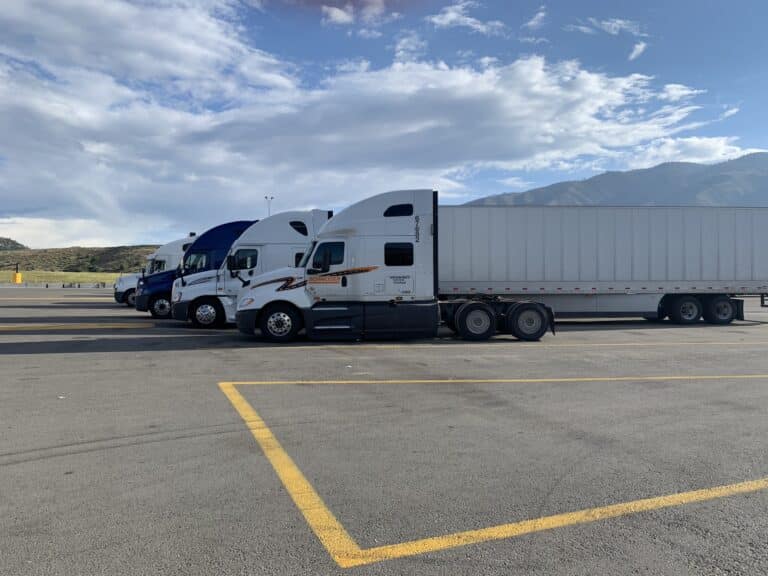Truckers have a lot to consider when choosing an electronic logbook for their business. They need to be mindful of compliance, price, the user-friendliness of each logbook app, and more. Considering the high turnover rate among drivers, it is vital to make their jobs easier, and the right elog can do much for them. Reading ELD trucking app reviews from real drivers is a great way to ensure the system is efficient and the provider is trustworthy.

HOS247


HOS247

Reviews from HOS247 users show that they appreciate the logbook’s ease of use, seamless integration and installation, dependability, and overall system performance. Our customer support reps are knowledgeable, available Monday through Sunday, and speak four languages (English, Russian, Polish, and Spanish). At HOS247, we serve as our customers’ strategic partners in developing their business. Their feedback helps us maintain an excellent logbook service for commercial drivers.

HOS247
HOS247


HOS247
HOS247

Reviews from HOS247 users show that they appreciate the logbook’s ease of use, seamless integration and installation, dependability, and overall system performance. Our customer support reps are knowledgeable, available Monday through Sunday, and speak four languages (English, Russian, Polish, and Spanish). At HOS247, we serve as our customers’ strategic partners in developing their business. Their feedback helps us maintain an excellent logbook service for commercial drivers.
HOS247 Offers More Than a Log Book App
In addition to a user-friendly ELD trucking app, HOS247 offers an all-in-one fleet management software to improve operations and safety, including:
- GPS fleet tracking. Use real-time GPS tracking to monitor your fleet with easy-to-install 4G/LTE tracking devices. Confirm driver HOS availability, vehicle details, and trailer type with a quick look at the map. Use GPS data to ensure drivers are on schedule and share estimated arrival times with clients for optimal customer service.
- IFTA calculations. Simplify IFTA fuel tax reporting with this feature. HOS247’s ELD trucking app automatically calculates each driver’s distance traveled by jurisdiction. Eliminate the administrative burden of calculating the distance to be taxed and avoid human error.

- Vehicle maintenance. The app helps keep an efficient maintenance schedule, reminding you when it is time for oil changes, warranty expiration dates, tire rotations, and more to prevent breakdowns and reparation costs.
- Automated idle monitoring. The logbook app for truck drivers automatically records idling to cut down on unnecessary fuel consumption. Use the dashboard to identify which drivers need additional training on the importance of fuel preservation.
Can ELD Records Be Edited?
It is important to note that driving time cannot be changed to non-driving. However, elogs can be edited if they are missing information or clarification is needed. ELD apps for truck drivers allow drivers to edit RODS as long as they:
- Do not overwrite the original record.
- Do not delete or shorten driving time.
- Follow the prompts to annotate the edits.
- Do not allow the elog username associated with a record to be edited and reassigned, except when:
- Assigning an unidentified record.
- Correcting team driver errors.
- Correcting a non-authenticated driving segment accepted by mistake.
- Do not allow edits or manual entries on an intermediate log, a driver’s login/logout activities, A CMV engine power up/shut down, or ELD malfunctions and data diagnostic events.

What Happens When an Electronic Logging Device Malfunctions?
If an electronic logbook presents a malfunction, the driver is responsible for notifying the motor carrier in writing within 24 hours. The driver must also reconstruct the record of duty status (RODS) for their current 24-hour work period. If they cannot retrieve the information for the previous seven consecutive days, these too must be reconstructed on paper. Manual log preparation must continue until the device is fixed, which should not take more than fourteen days or until the driver returns to the home terminal (if the trip is longer than 14 days). The electronic logbook must be either repaired or replaced after this point.
Are the Canada and United States Mandates Different ?

Similarities Between the U.S. and Canada ELD Mandates
The ELD trucking app and device have to fulfill several requirements that apply equally on both sides of the border:
- Automatic detection of driving status from 8 km/h. When traveling at 8 km/h or more, the log should automatically display the status as “driving”.
- Automatic return to “on duty” status after a 6-minute stop. After a 5-minute stop, the ELD trucking app must prompt a message on the screen asking the driver if they wish to change their duty status. If there is no response after one minute, the status will automatically change to “on duty” and the total 6 minutes will be registered as “driving”.
- “Yard move” feature. When driving within a customer’s yard, drivers may activate the “yard move” mode to remain “on duty” since the logbook will set the status to “driving” when moving at 8 km/h or more.
- Diagnostics and defect management. The elog must detect issues such as an odometer jump, disconnection from the device, etc.
- Unassigned driving management. When a driver registers in a vehicle, the logbook will prompt pending unassigned driving times. Drivers must accept or reject them.
- Change approval by drivers. Drivers will need to approve any changes on the ELD trucking app before they are applied to their logbook.
- No modification of automatically recorded driving. A driving segment automatically recorded when the vehicle exceeds 8 km/h cannot be shortened. The driver can annotate the driving segment to explain the situation in case of a problem. The driver can also change other statuses as needed.
Key Differences Between the U.S. and Canada ELD Mandates
On the other hand, the two mandates also have critical differences. It is important for carriers operating in both countries to be aware of these distinctions and prevent non-compliance.
- Personal conveyance. Special driving time status for drivers to set when they operate a vehicle for non-work purposes (example: when driving from the place of lodging to a restaurant). There are no limits on distance or time used for personal conveyance in the United States, but there is a strict distance limit of 75 kilometers for personal conveyance in Canada. The Canadian mandate will enforce this limit via automation. Once a driver hits the personal conveyance limit, the elog will force the ‘driving’ status and capture it as on-duty driving time.
- Off-duty status. Drivers in the United States must take a 30-minute rest break after driving for eight hours without pause. These breaks can be recorded as off-duty or sleeper berth time at truck stops or other rest areas. Truckers in Canada have a 16-hour window to complete their work, of which two hours must be off-duty time. The time can be spent as a single break of two hours or split into two one-hour breaks or four 30-minute off-time periods.
Note: Canada also allows drivers to defer unused off-duty time to the next day for a single day when carrying out operations south of the 60th parallel. - Transferring HOS at roadside inspections. In the United States, Hours of Service are transferred to ERODS, a data repository (electronic records of duty status). Elog providers are required to support a minimum of two of these methods. DOT officers can access the information they need for inspections from this repository. In Canada, electronic HOS logs are transferred directly to the officer. However, the database upload process will eventually be part of the Canadian mandate to simplify the transition.

- Use during malfunction. In the event of device failure, the driver’s hours of service can be recorded with an alternate method (usually a paper log) for a maximum of 8 days in the U.S. In Canada, the driver may use paper daily logs for as long as 14 days or until the trip ends back at the home terminal.
- Notification prior to violations. Unlike the U.S. regulations, the Canadian version requires the ELD trucking app to notify the driver at least 30 minutes before reaching any limit imposed by the current hours of service rules. This rule is intended to keep the driver informed and thus avoid violations for the driver and ensure road safety.
- Support for Canadian rules. In Canada, HOS rules have more situations and provisions. The log book app for truck drivers of choice will have to support them. These are the main situations that apply only in Canada:
- 2 cycles and 2 operating zones:
- South of 60th parallel: Cycle 1 (70 hours over 7 days) and Cycle 2 (120 hours over 14 days)
- North of 60th parallel: Cycle 1 (80 hours over 7 days) and Cycle 2 (120 hours over 14 days)
- 70 or 80 hours on-duty (depending on the cycle) requires 24 hours of consecutive off-duty time.
- Deferral of daily Off-duty time to the following day (day 1 / day 2) when operating south of the 60th parallel.
- 2 cycles and 2 operating zones:

I’ve co-founded, built and managed several transportation-related businesses. Now, I’m a founder and CEO of HOS247 – an AI Transportation Platform for trucking companies, freight brokers and other logistics operations. We are transitioning old-style operations to technology-advanced logistics entities and help them to grow their businesses. ELDs (electronic logging devices), fleet tracking and management 2.0 combined with AI-powered dispatch tools.












The electronic logging device (ELD) mandate has been a reality for Canadian truckers since January 2023, when Transport Canada’s regulations came into full effect. That’s over two years of truckers adapting to electronic hours of service (HOS) tracking. Electronic logs

Time is money in trucking, and losing track of equipment costs both. Vehicle tracking remains a significant challenge for many trucking companies, impacting operational efficiency and revenue. Modern asset tracking with GPS monitoring systems can help solve this issue. Gone

Fleet managers have a monumental responsibility in the trucking industry. Their job is multifaceted and complex, and a reliable fleet management vehicle tracking system is one of the best ways to streamline it. This article will look at the positive